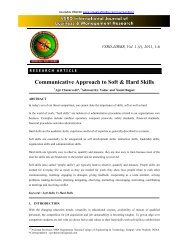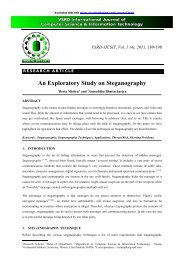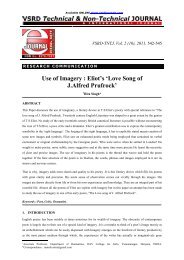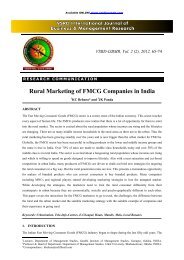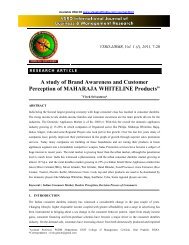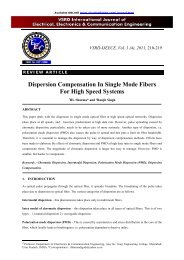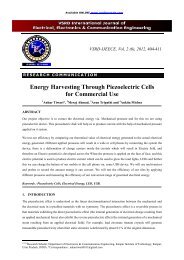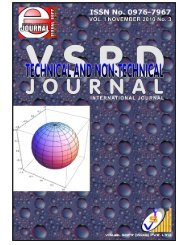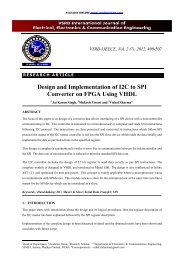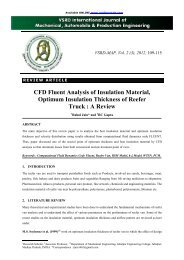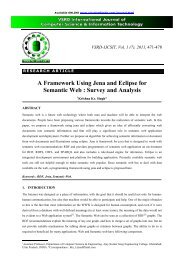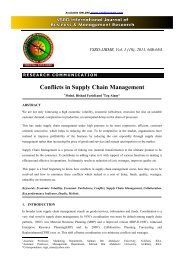DTC-SVM of Induction Motor with Three Level Diode Clamped Inverter
DTC-SVM of Induction Motor with Three Level Diode Clamped Inverter
DTC-SVM of Induction Motor with Three Level Diode Clamped Inverter
Create successful ePaper yourself
Turn your PDF publications into a flip-book with our unique Google optimized e-Paper software.
Available ONLINE www.visuals<strong>of</strong>tindia.com/vsrd/vsrdindex.html<br />
VSRD-TNTJ, Vol. I (4), 2010, 178-187<br />
R E S E A R C H A R T II C L E<br />
<strong>DTC</strong>-<strong>SVM</strong> <strong>of</strong> <strong>Induction</strong> <strong>Motor</strong> <strong>with</strong><br />
<strong>Three</strong> <strong>Level</strong> <strong>Diode</strong> <strong>Clamped</strong> <strong>Inverter</strong><br />
1 Jagan Mohan Rao Malla* and 2 Siva Ganesh Malla<br />
ABSTRACT<br />
Direct Torque Control is a control technique used in AC drive systems to obtain high performance torque<br />
control. The conventional <strong>DTC</strong> drive contains a pair <strong>of</strong> hysteresis comparators, a flux and torque estimator and a<br />
voltage vector selection table. The torque and flux are controlled simultaneously by applying suitable voltage<br />
vectors, and by limiting these quantities <strong>with</strong>in their hysteresis bands, de-coupled control <strong>of</strong> torque and flux can<br />
be achieved. However, as <strong>with</strong> other hysteresis-bases systems, <strong>DTC</strong> drives utilizing hysteresis comparators<br />
suffer from high torque ripple and variable switching frequency. The most common solution to this problem is<br />
to use the space vector <strong>with</strong> multilevel inverter depends on the reference torque and flux. The reference voltage<br />
vector is then realized using a voltage vector modulator. Several variations <strong>of</strong> <strong>DTC</strong>-<strong>SVM</strong> <strong>with</strong> three level<br />
inverter have been proposed and discussed in the literature. The work <strong>of</strong> this project is to study, evaluate and<br />
compare the various techniques <strong>of</strong> the <strong>DTC</strong>-<strong>SVM</strong> <strong>with</strong> three level inverter applied to the induction machines<br />
through simulations. The simulations were carried out using MATLAB/ SIMULINK simulation package.<br />
Evaluation was made based on the drive performance, which includes dynamic torque and flux responses,<br />
feasibility and the complexity <strong>of</strong> the systems. It is better technology in electric vehicles.<br />
Keywords: Multilevel <strong>Inverter</strong>, <strong>DTC</strong>-<strong>SVM</strong>, Converter, Electric Vehicles, Reliability, SVPWM, 3 <strong>Level</strong> <strong>Diode</strong><br />
Clamed <strong>Inverter</strong>.<br />
INTRODUCTION<br />
ULTILEVEL inverters have been developed to overcome harmonics in output, and improve the shape <strong>of</strong> output<br />
to reach sinusoidal waveform. By using PWM inverters have been developed to overcome shortcomings in<br />
solid-state switching device ratings.<br />
______________<br />
1 HOD, Electrical & Electronics Dept., Gandhi Institute <strong>of</strong> Engineering & Technology, Gunupur, Orissa, INDIA.<br />
2 Research Scholar, School <strong>of</strong> Electrical Sciences, Indian Institute <strong>of</strong> Technology, Bhubaneshwar, Orissa, INDIA.<br />
*Correspondence : malla_phd@yahoo.com
Jagan Mohana Rao Malla et. al / VSRD Technical & Non-Technical Journal Vol. I (4), 2010<br />
MULTILEVEL PARALLEL INVERTER FOR <strong>DTC</strong> OF INDUCTION MOTOR<br />
<strong>Induction</strong> motor torque control has traditionally been achieved using Field Oriented Control (FOC). This<br />
involves the transformation <strong>of</strong> stator currents into asynchronously rotating d-q reference frame that is typically<br />
aligned to the rotor flux. In this reference frame, the torque and flux producing components <strong>of</strong> the stator current<br />
are decoupled. A PI controller is then used to regulate the output voltage to achieve the reputed stator current<br />
and therefore torque. This PI controller limits the transient response <strong>of</strong> the torque controller.<br />
Direct Torque Control (<strong>DTC</strong>) uses an induction motor model to achieve a desired output torque. By using only<br />
current and voltage measurements, it is possible to estimate the instantaneous stator flux and output torque. An<br />
induction motor model is then used to predict the voltage required to drive the flux and torque to demanded<br />
values <strong>with</strong>in a fixed time period. This calculated voltage is then synthesized using space vector modulation<br />
(<strong>SVM</strong>).<br />
The stator flux vector, and the torque produced by the motor, Tem , can be estimated using and respectively.<br />
These only require knowledge <strong>of</strong> the previously applied voltage vector, measured stator current, and stator<br />
resistance.<br />
As shown in Fig 6, the voltage required to drive the error in the torque and flux to zero is calculated directly.<br />
The calculated voltage is then synthesized using Space Vector Modulation. If the inverter is not capable <strong>of</strong><br />
generating the required voltage then the voltage vector which will drive the torque and flux towards the demand<br />
value is chosen and held for the complete cycle.<br />
Fig 1(a) : General Block Diagram <strong>of</strong> <strong>DTC</strong><br />
Page 179 <strong>of</strong> 187
Jagan Mohana Rao Malla et. al / VSRD Technical & Non-Technical Journal Vol. I (4), 2010<br />
Fig 1(b) : Basic <strong>DTC</strong> <strong>Induction</strong> <strong>Motor</strong> Scheme<br />
Fig 1(c) : System Diagram <strong>of</strong> PS<strong>SVM</strong>-<strong>DTC</strong><br />
Fig 2(a) : Space Vector Modulation for 3 <strong>Level</strong> <strong>Inverter</strong><br />
Page 180 <strong>of</strong> 187
Jagan Mohana Rao Malla et. al / VSRD Technical & Non-Technical Journal Vol. I (4), 2010<br />
Fig 2(b) : Pulse Generation For <strong>Three</strong> <strong>Level</strong> <strong>Diode</strong> <strong>Clamped</strong> <strong>Inverter</strong><br />
SIMULATION RESULTS<br />
Fig 3(a)<br />
Fig 3(b)<br />
Fig. 3(a) : Diagram <strong>of</strong> General <strong>DTC</strong> and<br />
Page 181 <strong>of</strong> 187
Jagan Mohana Rao Malla et. al / VSRD Technical & Non-Technical Journal Vol. I (4), 2010<br />
Fig 3(b) : Diagram <strong>of</strong> <strong>DTC</strong>-<strong>SVM</strong> <strong>with</strong> three level diode clamped using SIMULINK/MATLAB<br />
Fig. 4 (a) and (b) show the simulation results for load stator currents for general and <strong>DTC</strong>-<strong>SVM</strong> <strong>with</strong> three level<br />
diode clamped inverter respectively for a reference speed <strong>of</strong> 1440 rpm. As shown, reduces steady-state ripple in<br />
stator current.<br />
Fig (a)<br />
Fig (b)<br />
Fig. 4 : Simulation results for stator current <strong>of</strong> (a) general <strong>DTC</strong> (b) <strong>DTC</strong>-<strong>SVM</strong> <strong>with</strong><br />
three level diode clamped inverter for 1440 rpm.<br />
Fig. 5 (a) and (b) show the stator flux response for general and <strong>DTC</strong>-<strong>SVM</strong> <strong>with</strong> three level diode clamped<br />
inverter respectively for a reference speed <strong>of</strong> 1440 rpm. The classical <strong>DTC</strong> uses a constant flux command <strong>of</strong><br />
0.742 Wb, whereas <strong>SVM</strong> method uses an optimized value, which 0.989 Wb. The <strong>SVM</strong> method reduces the flux<br />
ripple to a considerable lower mount.<br />
Page 182 <strong>of</strong> 187
Jagan Mohana Rao Malla et. al / VSRD Technical & Non-Technical Journal Vol. I (4), 2010<br />
Fig (a)<br />
Fig (b)<br />
Fig. 5 : Simulation results for flux response <strong>of</strong> (a) general <strong>DTC</strong> (b) <strong>DTC</strong>-<strong>SVM</strong> <strong>with</strong><br />
three level diode clamped inverter for 1440 rpm<br />
Fig.6 (a) and (b) show the 3-phase stator current for general and <strong>DTC</strong>-<strong>SVM</strong> <strong>with</strong> three level diode clamped<br />
inverter respectively for a reference speed <strong>of</strong> 1440 rpm. An on load torque applied at 2 second. The enlarged<br />
view <strong>of</strong> Fig.11 (a) and (b) at a torque load condition is presented. The proposed method (<strong>DTC</strong>-<strong>SVM</strong> <strong>with</strong> three<br />
level inverter) is able to reduce ripples in 3-phase stator current as well.<br />
Fig (a)<br />
Page 183 <strong>of</strong> 187
Jagan Mohana Rao Malla et. al / VSRD Technical & Non-Technical Journal Vol. I (4), 2010<br />
Fig (b)<br />
Fig. 6 Simulation results for stator current <strong>of</strong> (a) general <strong>DTC</strong> (b) <strong>DTC</strong>-<strong>SVM</strong> <strong>with</strong><br />
three level diode clamped inverter for 1440 rpm<br />
Fig.7 (a) and (b) Show the speed for general and <strong>DTC</strong>-<strong>SVM</strong> <strong>with</strong> three level diode clamped inverter<br />
respectively for a reference speed <strong>of</strong> 1440 rpm. It is observed that, the transient and steady state ripples are less<br />
in <strong>DTC</strong>-<strong>SVM</strong>.<br />
Fig (a)<br />
Fig (b)<br />
Fig. 7 Simulation results for Speed <strong>of</strong> (a) general <strong>DTC</strong> (b) <strong>DTC</strong>-<strong>SVM</strong> <strong>with</strong> three<br />
level diode clamped inverter for 1440 rpm<br />
Fig.8 (a) and (b) Show the 3-phase output voltages for general and <strong>DTC</strong>-<strong>SVM</strong> <strong>with</strong> three level diode clamped<br />
inverter respectively for a reference speed <strong>of</strong> 1440 rpm. It is observed that, in on load condition the output<br />
Page 184 <strong>of</strong> 187
Jagan Mohana Rao Malla et. al / VSRD Technical & Non-Technical Journal Vol. I (4), 2010<br />
voltage ripples are reduced in <strong>DTC</strong>-<strong>SVM</strong> <strong>with</strong> three level inverter.<br />
Fig (a)<br />
Fig (b)<br />
Fig. 8 Simulation results for 3-phase voltages <strong>of</strong> ((a) general <strong>DTC</strong><br />
(b) <strong>DTC</strong>-<strong>SVM</strong> <strong>with</strong> three level diode inverter for 1440 rpm<br />
Fig. 9 (a) and (b) show stator flux trajectory for general and <strong>DTC</strong>-<strong>SVM</strong> <strong>with</strong> three level diode clamped inverter<br />
respectively for a reference speed <strong>of</strong> 1440 rpm. The smoother flux trajectory for the proposed one confirms the<br />
ripple reduction in torque, flux, stator current and speed response.<br />
Fig (a)<br />
Fig (b)<br />
Fig. 9 (c) and (d) show electric torque response for general and <strong>DTC</strong>-<strong>SVM</strong> <strong>with</strong> three level diode clamped<br />
inverter respectively a reference speed <strong>of</strong> 1440 rpm. A step change in load torque from 20 N-m to 5 N-m is<br />
Page 185 <strong>of</strong> 187
Jagan Mohana Rao Malla et. al / VSRD Technical & Non-Technical Journal Vol. I (4), 2010<br />
applied at 1.5 second. In addition to the inherent disadvantages <strong>of</strong> general <strong>DTC</strong>, the constant reference flux<br />
causes higher ripple at lower torque level. The proposed (<strong>DTC</strong>-<strong>SVM</strong> <strong>with</strong> three level diode clamped inverter)<br />
method causes lower ripple at lower torque level. In addition to the torque ripple minimization (~1/12 th ), this<br />
method is also able to eliminate the torque under-shoot and over-shoots.<br />
30<br />
30<br />
T o rq u e (N -m )<br />
20<br />
10<br />
0<br />
T o rq u e (N -m )<br />
20<br />
10<br />
0<br />
-10<br />
1.0 1.25 1.5 1.75 2.0<br />
Time (Sec)<br />
-10<br />
1.0 1.25 1.50 1.75 2.0<br />
Time (Sec)<br />
Fig (c)<br />
Fig (d)<br />
Fig. 9 : Simulation results for torque response <strong>of</strong> (c) general <strong>DTC</strong> (d) <strong>DTC</strong>-<strong>SVM</strong><br />
<strong>with</strong> 3 level diode inverter for 1440 rpm<br />
CONCLUSION<br />
This technology is better for <strong>DTC</strong> applications and it is very suitable for electric vehicles. Direct Torque Control<br />
is supposed to be one <strong>of</strong> the best controllers for driving any induction motor. Its principles and basic concepts<br />
have been introduced and thoroughly explained. It is also demonstrated in the thesis that the method <strong>of</strong> direct<br />
torque control also allows the decoupled control <strong>of</strong> motor torque and motor stator flux. According to the<br />
analysis, the <strong>DTC</strong> strategy is simpler to implement than the flux vector control method because it does not<br />
require voltage modulators, and co-ordinate transformations. However, it introduces undesired torque ripple and<br />
minimize ripples by using multilevel inverter.<br />
In this work, the three-level inverter effectively operates as a two-level inverter. This allows for a significant<br />
reduction in the rating requirements <strong>of</strong> the clamping diodes, which would result in a lower cost implementation<br />
<strong>of</strong> this topology. The paper also extends the parallel topology to the use <strong>of</strong> a charge pump circuit as a method to<br />
obtain the required independently referenced gate drive power supplies. This charge pump circuit eliminates the<br />
need for individual power transformers for each <strong>of</strong> the gate drive supplies which significantly reduces the cost<br />
and size <strong>of</strong> these required supplies. With these proposed methods, a low power motor drive was constructed<br />
using inexpensive high-volume low-voltage power MOSFETs and other low cost discrete components. Thus the<br />
paper demonstrates the possibility <strong>of</strong> basing a low power motor drive around inexpensive power MOSFET<br />
switches that previously could not be used due to voltage limitations. While the proposed converter was<br />
constructed using discrete power devices, it should be noted that the two-level control principle and four-level<br />
charge pump make this topology attractive for integration into a single device package much like a standard sixpack<br />
arrangement. With the lower voltage rating requirement <strong>of</strong> the main switches, and the familiar and<br />
standard two-level control principles, this topology could become even more economical than a standard twolevel<br />
inverter depending on what future device dies are developed and manufactured. This is important since the<br />
trend <strong>of</strong> integration into standard packages and automated manufacturing focus attention on performance and<br />
total cost while making the actual topology inside the package <strong>of</strong> lesser importance.<br />
Page 186 <strong>of</strong> 187
Jagan Mohana Rao Malla et. al / VSRD Technical & Non-Technical Journal Vol. I (4), 2010<br />
REFERENCES<br />
[1] Jose Rodriguez, Jih-Sheng Lai, and Fang Zheng Peng, “Multilevel <strong>Inverter</strong>s: A Survey <strong>of</strong> Topologies,<br />
Controls, and Applications”, IEEE Transactions on Industrial Electronics, Vol. 49, No. 4, August 2002.<br />
pages 724-738.<br />
[2] Leon M. Tolbert and Thomas G. Habetler, “Novel Multilevel <strong>Inverter</strong> Carrier-Based PWM Method”, IEEE<br />
Transactions on industry applications, Vol. 35, No.5, sep/oct 1999. pages 1098 – 1107.<br />
[3] Zhong Du, Leon M. Tolbert, John N. Chiasson, and Burak Ozpineci, “A Cascade Multilevel <strong>Inverter</strong> Using<br />
a Single DC Source”, 0-7803-9547-6/06/$20.00 © 2006 IEEE pages 426-430.<br />
[4] Remus Teodorescu, Frede Blaabjerg, John. K. Pedersen, Ekrem Cengelci, and Prasad N. Enjeti, “Multilevel<br />
<strong>Inverter</strong> by Cascading Industrial VSI”, IEEE Transaction on industrial electronics, Vol.49, No.4, August<br />
2002. pages 832-838.<br />
[5] Xiaoming Yuan, Lvo Barbi, “A New <strong>Diode</strong> Clamping Multilevel <strong>Inverter</strong>”, 0-7803-5160-6/99/$10.00 ©<br />
1999 IEEE. pages 495-501.<br />
[6] Madhav D. Manjrekar, Peter K. Steimer, and Thomas A. Lipo, “Hybrid Multilevel Power Conversion<br />
System: A Competitive Solution for High-Power Applications” IEEE Transaction on Industry Applications,<br />
Vol. 36, No. 3, May/June 2000. pages 834-841.<br />
[7] Miguel Lopez G, Luis Moran T, Jose Espinoza C and Juan Dixon R, “Performance Analysis <strong>of</strong> a Hybrid<br />
Asymmetric Multilevel <strong>Inverter</strong> for High Voltage Active Power Filter Applications”, 0-7803-7906-<br />
3/03/$17.00 ©2003 IEEE, pages 1050-1055<br />
[8] Jamal Al-Nasseir, Christian Weindl, Gerhard Herold and Joerg Flotthmesch, “A Dual-use Snubber Design<br />
for Multi-<strong>Level</strong> <strong>Inverter</strong> Systems”,1-4244-0121-6/06/$20.00.©2006 IEEE, pages 683-688<br />
[9] Gui-jia Su and Donald J.Adams, “Multilevel DC Link <strong>Inverter</strong> for Brushless Permanent magnet <strong>Motor</strong>s<br />
<strong>with</strong> Very Low Inductance”, IEEE IAS annual Meeting, September 30 – October 5, 2001.<br />
[10] L. Li D. Czarkowski, Y.Liu P. Pillay, “Multilevel Selective Harmonic Elimination PWM in Series-<br />
Connected Voltage <strong>Inverter</strong>s”, 0-7803-4943-1/98/$10.00 (c) 1998 IEEE.<br />
[11] Leon M. Tolbert and Thomas G. Habetler, “Novel Multilevel <strong>Inverter</strong> Carrier-Based PWM Methods”,<br />
IEEE IAS 1998 Annual Meeting, St. Louis, Missouri, October 10-15, 1998, pp. 1424-1431.<br />
[12] Nikolaus P. Schibli, Tung Nguyen, and Alfred C. Rufer, “A <strong>Three</strong>-Phase Multilevel Converter for High-<br />
Power <strong>Induction</strong> <strong>Motor</strong>s”, IEEE Transactions on Power Electronics, Vol. 13, No. 5, September 1998.<br />
pages 978-986.<br />
[13] Domenico casadei, Francesco Pr<strong>of</strong>umo, Giovanni, Angleo Tani.”FOC and <strong>DTC</strong>: Two Viable Schemes<br />
for <strong>Induction</strong> <strong>Motor</strong> Control”, IEEE Transaction on Power Electronics, vol.17, no. 5, September 2002.<br />
[14] Hamid Reza Keyhani, Mohammad Zolghadri, Abdollah Homaifar. “An extended and Improved Discrete<br />
Space Vector Modulation Direct Torque Control for <strong>Induction</strong> <strong>Motor</strong>”, 35 th<br />
Electronics Specialists Conference 2004.<br />
Annual IEEE Power<br />
[15] Leon M. Tolbert, Fang Z. Peng, and Thomas G. Habetler, “Multilevel <strong>Inverter</strong>s for Electric Vehicle<br />
Applications”, WEPT’98, Dearborn, Michigan, October 22-23, 1998.<br />
<br />
Page 187 <strong>of</strong> 187



